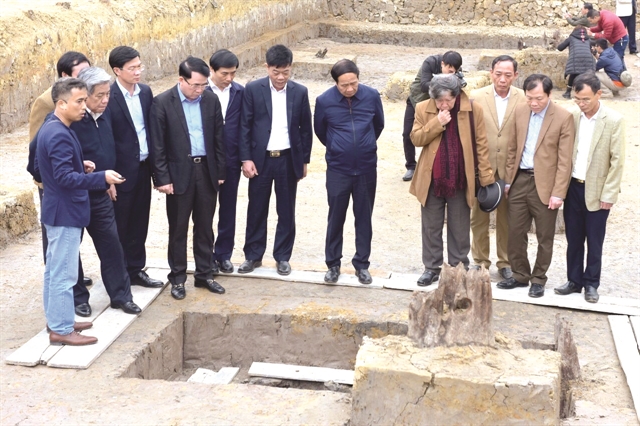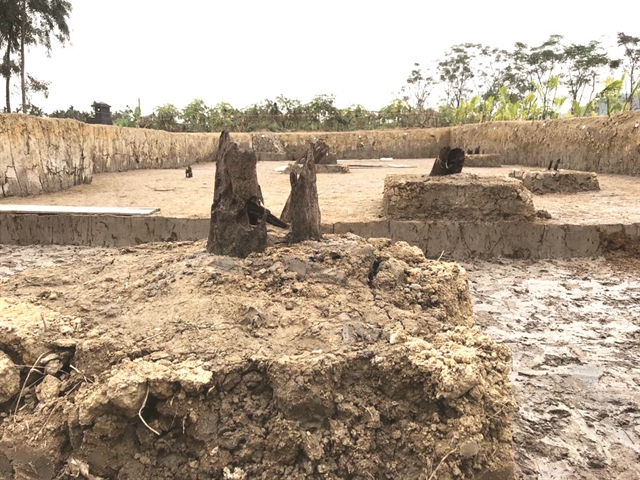 Life & Style
Life & Style

Archaeologists have shared a common opinion that the recent unearthed pile area in coastal city of Hải Phòng show a mass scale of Bạch Đằng River victory in 1288 by the navy troop of Đại Việt (the then Việt Nam) against Yuan-Mongol invaders.
HÀ NỘI — Archaeologists have recently unearthed wooden stakes that are thought to have been planted in a river in the coastal city of Hải Phòng to repel Yuan-Mongol invaders' boats and secure the Bạch Đằng River victory in 1288 for Đại Việt (then Việt Nam).
Researcher Bùi Văn Hiếu from the Việt Nam Archaeology Institute said the stakes would have been deployed by Trần Dynasty (1226-1400) fighters as a trap to destroy enemy boats and divert the current.

|
| An aerial view of the excavation site at Cao Quỳ. — VNA/VNS Photo An Đăng |
The historic victory reported in records has been proved by traces of wooden stakes on the river bed found in Yên Giang, Đồng Vạn Muối and Đồng Má Ngựa in the northern province of Quảng Ninh.
Recently, traces of the same wooden stakes have been unearthed in Liên Khê Commune, Thủy Nguyên District, Hải Phòng City.
They were discovered by chance near the Đá Bạc River dyke by locals. The stakes measured 3-4m in height with a diameter of 30cm.
Experts examined the stakes and decided to excavate the site. Nine stakes were found in early November 2019, which were tested by radio carbon [carbon-14] dating that found they came from between 1270 and 1430 AD.
At the end of November, the site was expanded to 950sq.m with three digs, where archaeologists found 27 stakes.
According to locals, this was not the first time such a discovery had been made. For example, 30 years ago a family found 10 stakes in the same area.

|
| Local leaders and scientists examine one of the stakes. — VNA/VNS Photo An Đăng |
Trần Văn Do, another farmer in Quỳ Khê Village, found three wooden stakes in 1970, with diameters of 35-50cm.
Archaeologists have also examined Thụ Khê Temple, Mai Động Pagoda and Thiểm Khê Pagoda, which history books say were involved in the victory.
According to records, Emporer Hưng Đạo Vương Trần Quốc Tuấn (1228-1300) visited the site to train his troops and set the trap.
Trap set
“We think this area was where the third battle of the Bạch Đằng River took place in 1288,” researcher Bùi Văn Hiếu said. “The trap was likely designed to prevent Yuan-Mongol ships from entering Giá River where Trần Quốc Tuấn’s army was. The invaders had no other choice but to travel along the Đá Bạc River to the Bạch Đằng River, where pointed stakes had been set to damage their boats.”

|
| The site in Cao Quỳ is believed to have been part of an underwater trap that secured the historic victory against Yuan-Mongol invaders in 1288. — Photo news.vienvong.com |
“The Bạch Đằng River victory ended the Yuan-Mongol troops hopes of invading Đại Việt,” he said.
Researcher Doãn Đình Lâm, from the Việt Nam Science Academy said feudal dynasties from the north that tried to invade Việt Nam using the waterways chose the mouth of the Bạch Đằng River, which is deeper than the river itself.
Lâm said he believed there were other stake traps set up along the river that were yet to be found.
Professor Lê Văn Lan said the findings changed what historians had previously thought of the battle.

|
| Scientists suggest that the site can be considered as a world heritage. — VNS/VNS Photo An Đăng |
"We only knew that the Trần army had lured the enemy down the Bạch Đằng River, and set the stakes late at night when the tide was high.
“The Trần army then engaged the enemy in the early morning when the tide was too low for their boats to flee to the sea. They were trapped by the wooden stakes,” he said.
“But now we know it was a huge military campaign, not just a single battle,” he said. “The Trần army planned to set up a system of traps all along the Bạch Đằng River.”
Researcher Vũ Minh Giang, deputy chairman of the Culture Heritage Council, said many historians from around the world had praised the tactics.
“The Yuan-Mongol empire was extremely powerful,” he said. “It stretched from the Pacific Ocean to the Mediterranean Sea. They won every battle.
“In their efforts to invade Southeast Asia, they fought Đại Việt three times (1257-58; 1284-85 and 1287-88), and lost every time.
After their defeat in 1288, the empire gradually weakened and collapsed. The victory helped prevent the empire from invading Japan and Southeast Asia,” he said.
Professor Trần Đình Thành, deputy director of the Culture Heritage Department, said the new findings showed the great significance of the battle.
“Before scientists conducted separate research in different areas. Now we have connection. We should conduct more excavations and rebuild the victory in 3D images so that people can understand its scale. Many international scientists consider it a global victory, which should be regarded as a world heritage.”
Thành suggested that local authorities should submit an application for recognition as a national relic site.
He also instructed agencies to protect the sites from erosion.
Bạch Đằng River, which runs through Quảng Yên Town (Quảng Ninh Province) to Thủy Nguyên District (Hải Phòng Province) also witnessed the historic victories of Ngô Quyền (897-944) and Lê Hoàn (941-1005). — VNS




